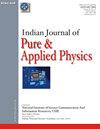A Vibrational Spectroscopic Method for Detection of Rheumatoid Arthritis using Bodily Fluids
IF 1.1
4区 物理与天体物理
Q4 PHYSICS, MULTIDISCIPLINARY
引用次数: 0
Abstract
Rheumatoid arthritis (RA) has a significant level of clinical variability and is also diagnosed based on a variety of clinical factors. The absence of bio-marker prediction approach makes prompt identification and therapeutic diagnosis of these individuals difficult. With the advent of targeted medicines, it has become increasingly crucial to diagnose RA early in order to provide safe and timely disease management that can minimize long-term consequences that include joint tissue damage. Raman spectroscopy is currently gaining clinical acceptability as a label-free, non-invasive tool for obtaining a thorough biochemical signature of biological sample composition. The purpose of this research was to look at using confocal Raman spectroscopy in conjunction with statistical data analysis as an auxiliary or supplementary tool for completing the diagnostic process of RA using peripheral blood serum. Raman intensities and Functional group frequencies are assigned to amide chains in proteins and other intermediate structural components such as lipids of a normal individual and a RA patient were distinguished, and biochemical alterations were found. Experimental results shows that spectral shift in region I and region II in Figure 1 identifies the concentration of nucleic acids and TNF-α increases respectively, which causes inflammation in our body that initiates RA disease.用体液检测类风湿性关节炎的振动光谱方法
类风湿关节炎(RA)具有显著的临床变异性,也是基于多种临床因素诊断的。由于缺乏生物标志物预测方法,使得这些个体难以及时识别和治疗诊断。随着靶向药物的出现,早期诊断RA变得越来越重要,以便提供安全和及时的疾病管理,从而最大限度地减少包括关节组织损伤在内的长期后果。拉曼光谱作为一种无标签、无创的工具,目前正在获得临床可接受性,用于获得生物样品组成的彻底生化特征。本研究的目的是将共聚焦拉曼光谱与统计数据分析相结合,作为辅助或补充工具,利用外周血血清完成RA的诊断过程。拉曼强度和功能基团频率被分配到蛋白质和其他中间结构成分(如正常人和RA患者的脂质)中的酰胺链上,并发现了生化改变。实验结果表明,图1中I区和II区光谱位移分别表明核酸和TNF-α浓度升高,从而引起我们体内炎症,引发RA疾病。
本文章由计算机程序翻译,如有差异,请以英文原文为准。
求助全文
约1分钟内获得全文
求助全文
来源期刊
CiteScore
1.30
自引率
14.30%
发文量
42
审稿时长
7 months
期刊介绍:
Started in 1963, this journal publishes Original Research Contribution as full papers, notes and reviews on classical and quantum physics, relativity and gravitation; statistical physics and thermodynamics; specific instrumentation and techniques of general use in physics, elementary particles and fields, nuclear physics, atomic and molecular physics, fundamental area of phenomenology, optics, acoustics and fluid dynamics, plasmas and electric discharges, condensed matter-structural, mechanical and thermal properties, electronic, structure, electrical, magnetic and optical properties, cross-disciplinary physics and related areas of science and technology, geophysics, astrophysics and astronomy. It also includes latest findings in the subject under News Scan.

 求助内容:
求助内容: 应助结果提醒方式:
应助结果提醒方式:


